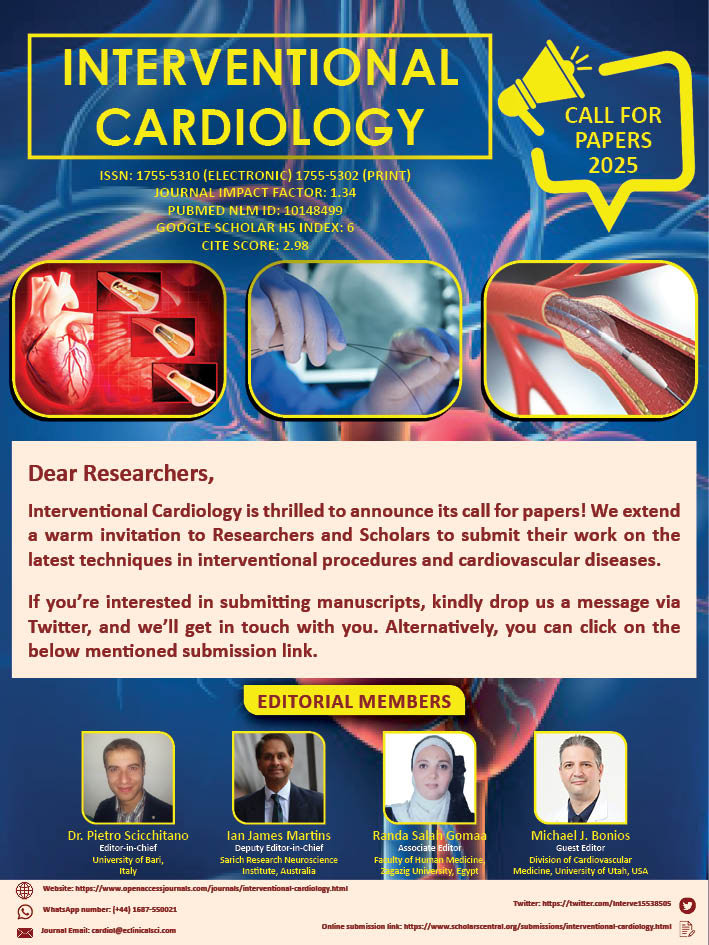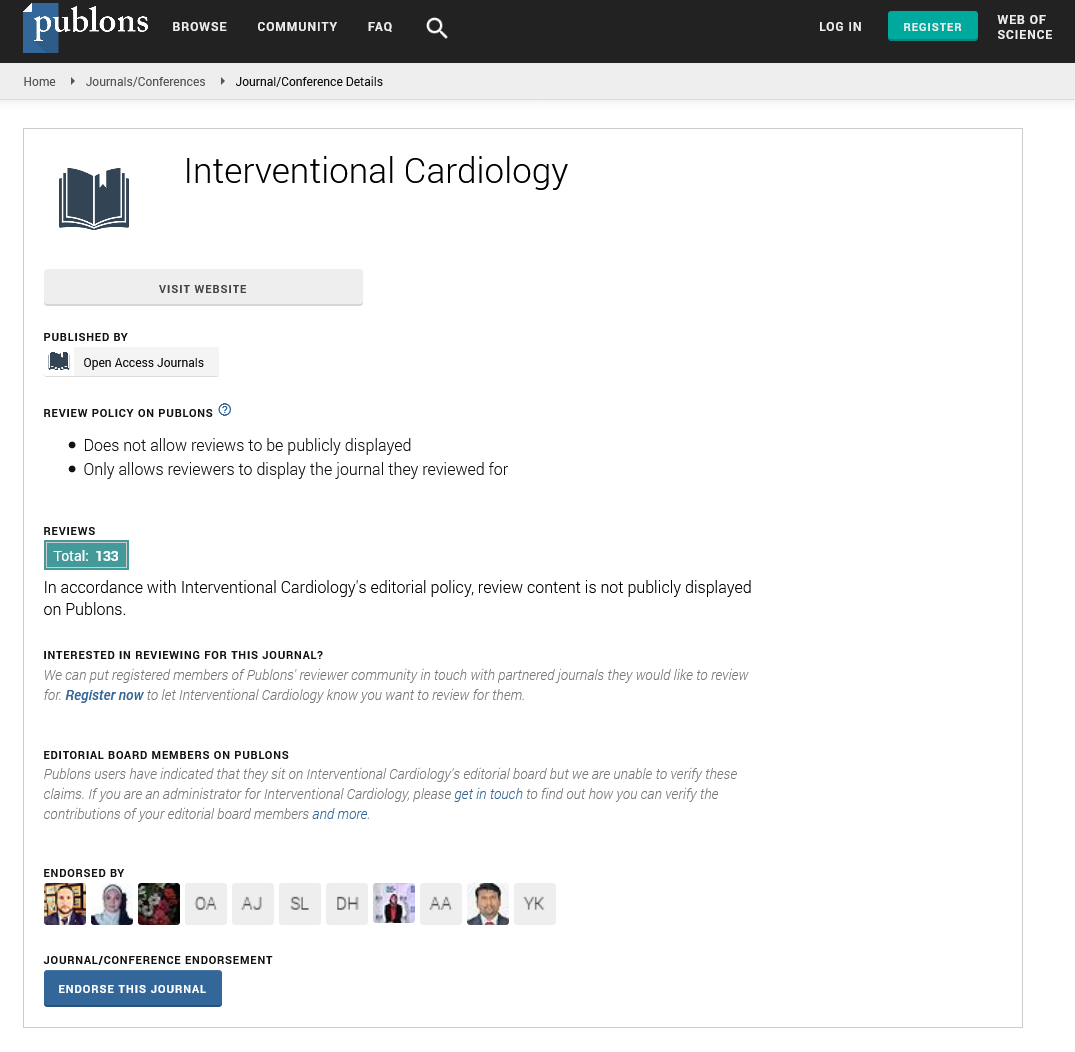Short Commentary - Interventional Cardiology (2025) Volume 17, Issue 2
Third-Generation LVAD Rotor Dislodgement: A Short Commentary on Cautions, Diagnosis, and Management
- Corresponding Author:
- Tyler Lee
Jefferson Abington Hospital, Abington, United States of America
E-mail: 13leety@gmail.com
Received date: 03-Mar-2025, Manuscript No. FMIC-25-165148; Editor assigned: 05-Mar-2025, PreQC No. FMIC-25-165148 (PQ); Reviewed date: 19-Mar-2025, QC No. FMIC-25-165148; Revised date: 26-Mar-2025, Manuscript No. FMIC-25-165148 (R); Published date: 02-Apr-2025, DOI: 10.37532/1755-5310.2025.17(1).973
Abstract
T he number of Left Ventricular Assist Devices (LVADs) utilized in advanced heart failure patients has significantly risen over the past decade as technological advancements become more refined. With the latest third-generation models using centrifugal flow and magnetically levitated rotors (such as the HeartMate 3), destination therapy is becoming more common. Although adverse events have dwindled with each LVAD generation, complications can still occur. A notably rare undocumented case of a third generation LVAD rotor dislodgment was identified in a 77-year-old male. Although the exact cause remains unclear, the case highlights the importance of post-market surveillance, regular follow-up, and patient education. As LVADs trend towards long term use, proactive monitoring and reporting are essential to ensure patient safety and optimizing therapeutic outcomes.
Keywords
HeartMate 3 . Third-generation LVAD . Adverse event . Rotor dislodgement
Description
Since the Heartmate 3 LVADâs release in 2017, both survival and quality of life among advanced heart failure patients have improved. Over the past decade, the number of LVAD implantations has steadily increased as the introduction of centrifugal flow technology and magnetically levitated rotors has proven more effective in reducing pump complications compared to previous LVAD generations. In fact, an annual report from INTERMACS 2023 showed that patients with third-generation LVADs experienced significantly fewer adverse events over 5 years. These events included gastrointestinal bleeding, stroke, pump thrombus, and device malfunction [1]. After the third-generation LVADsâ approval by the United States Food and Drug Administration in 2018, the clinical indication for LVADs has shifted beyond their traditional role as a bridge to transplant toward more frequent use as destination therapy [2].
Despite these improvements, adverse events still occur with third-generation LVADs. The most common complications are gastrointestinal bleeding, stroke, and infection [3]. Additionally, system malfunctions (including controller faults, battery issues, communication failures, and driveline power faults) have been reported to manufacturers [4]. To support early recognition and management of these complications, LVAD manufacturers provide alarm guides for clinicians and patients, allowing for timely troubleshooting and intervention [5].
Rarely do pump complications occur, especially with the third-generation LVADs. However, there have been several product recalls that have drawn attention to vulnerabilities in its latest design that should be noted. For example, in 2018, a recall was issued due to the risk of malfunction in the outflow graft, which created concern of an increased chance of pump occlusion and reduced pump flow [6]. More recently, 2 recalls were issued in 2024. One recall was initiated following 273 reported injuries and 14 deaths associated with biological material buildup causing extrinsic outflow graft obstruction [7]. The other recall followed 81 reported incidents related to internal leaks of blood and air within the pump housing, resulting in 70 reported injuries and 2 deaths [8]. Notably, there have been no publicly documented reports or recalls of mechanical pump failure due to rotor dislodgment.
The first third-generation LVAD rotor dislodgment was documented in a case of a 77-year-old male with hypertension, anxiety, and non-ischemic cardiomyopathy (stage D, New York Heart Association functional class IV) status post HeartMate 3 third-generation LVAD as destination therapy who presented initially with recurring low flow and wrench alarms with rattling sounds emitting from his chest. The nature of this adverse event had the potential for catastrophic outcomes such as compromised flow and third-degree burns with internal device temperatures reaching as high as 100°C. Fortunately, the patient remained asymptomatic throughout the event (although he did present with lightheadedness that was thought to be due to overmedicating on hydralazine and isosorbide, which resolved with intravenous fluids). The rattling from the rotor dislodgement resolved with the patient temporarily disconnecting the controller from the driveline during a controller change, which not only resets the LVAD system but also resets the rotorâs magnetic axis, leading to a stable rotor on the next power on [9].
Diagnosing a rare and previously undocumented complication requires a high index of suspicion. Of course, LVAD interrogation plays a significant role in diagnosing adverse events, but clinical history and physical exams are also key. Mechanical pump failure, such as rotor dislodgement, should be considered if a patient presents with frequent low flow and yellow wrench alarms. Caution and concerns should definitely be addressed with red wrenched alarms, as no description. Exists of the underlying complication in the alarm guide for this complication. Further suspicion of a rotor dislodgement is supported by an audible rattle on chest auscultation or if the patient reports a change in the normal sound of the device. It's imperative that patients experiencing these types of findings and symptoms call their LVAD hospital team for further workup. Discussion with the manufacturer after sending waveform data from the LVAD system should be done, as this adverse event is not well documented. For safety, patients should be advised to lie down while having someone assist in disconnecting the controller from the driveline to temporarily interrupt power to the device, allowing the rotor to disengage from the magnet.
The etiology of rotor dislodgment in this case remains unclear. Pump thrombosis, which is a common cause of flow disruption and a potential cause of rotor issues, and other structural causes influenced by the patient on the LVAD were ruled out on CT imaging. Unfortunately, upon interrogation and collaboration with the manufacturer, the LVAD event log was overwritten with speed changes due to frequent alarm events. Because of this, there was no record of what immediately led to the malfunction. Causes could only be theorized, including electrical and mechanical failure, low power, and external influences, most likely from an ingested thrombus (although not seen on imaging).
The patient had a history of poorly controlled hypertension, with intermittent spikes in blood pressure attributed to frequent anxiety. Hypertension has been proven to reduce the pump flow, resulting in reduced cardiac output and a higher risk of pump thrombosis [10]. However, no literature currently describes a direct relationship between chronic uncontrolled hypertension and mechanical degradation or dislodgment of pump components. This raises the possibility that uncontrolled blood pressure or device stress from repeated low-flow states may exert unpredictable forces on the rotor mechanism over time. Nevertheless, further study is needed to explore LVAD interactions and circulatory dynamics.
While the number of adverse events has declined with each new generation of LVAD technology, continuous post-market surveillance, detailed case reporting, and device refinement are still necessary. As LVADs are increasingly used for destination therapy, patient education and close follow-up become crucial. Educating patients and caregivers on alarm interpretation, routine maintenance, and when to seek emergency care can greatly improve outcomes and reduce morbidity. Establishment of strong relationships between physicians and LVAD recipients not only builds trust but also facilitates early symptom reporting and promotes timely interventions regarding patientsâ LVAD system.
References
- Jorde UP, Saeed O, Koehl D, et al. The Society of thoracic surgeons intermacs 2023 annual report: Focus on magnetically levitated devices. Ann Thorac Sur. 117(1):33-44 (2024).
- Eisen HJ, Flack JM, Atluri P, et al. Management of hypertension in patients with ventricular assist devices: A scientific statement from the American Heart Association. Circ Heart Fail. (5):e000074 (2022).
- Thompson JH, Faulkner K, Lee C, et al. Adverse events in patients with a left ventricular assist device: Are patient-reported outcomes affected?. Eur J Cardiovasc Nurs. 21(3):254-260 (2022).
- Kormos RL, McCall M, Althouse A, et al. Left ventricular assist device malfunctions: It is more than just the pump. Circulation. 136(18):1714-1725 (2017).
- Abbott medical. Heartmate 3 LVAS Alarms for clinicians. Pleasanton, CA. (2022).
- Heaton JN, Singh S, Li M, et al. Adverse events with heartmate-3 left ventricular assist device: Results from the Manufacturer and User Facility Device Experience (MAUDE) database. Indian Heart J. 73(6):765-767 (2021).
- US. Food and Drug Administration. Abbott/Thoratec Corp. Recalls heartmate II and heartmate 3 Left Ventricular Assist System (LVAS) due to long-term buildup causing an obstruction.
- US. Food and Drug Administration. Abbott recalls heartmate 3 Left Ventricular Assist System (LVAS) implant kit for risk of blood leakage or air entering system between inflow cannula and apical cuff.
- Lee T, Janga C, Haddad E, et al. First documented case of a third-generation LVAD rotor dislodgement. JACC Case Rep. 30(5):103114 (2025).
- Shehab S, Jain P, Adji A, et al. Understanding the impact of hypertension on left ventricular assist device pump function and thrombotic risk. ASAIO J. 67(7):e118-e119 (2021).

